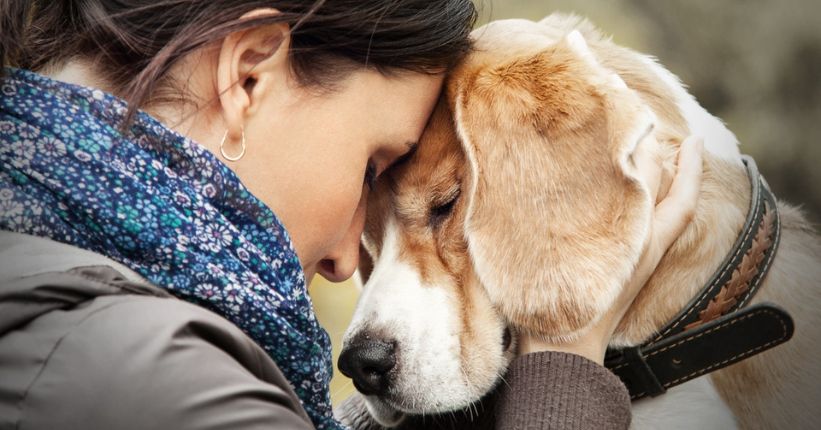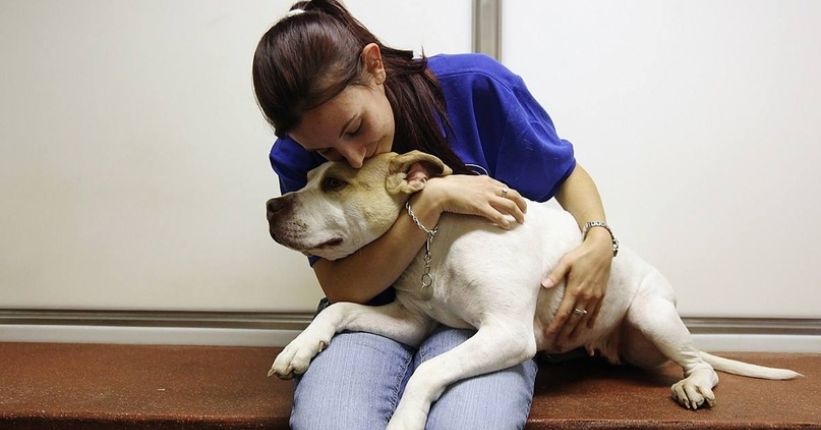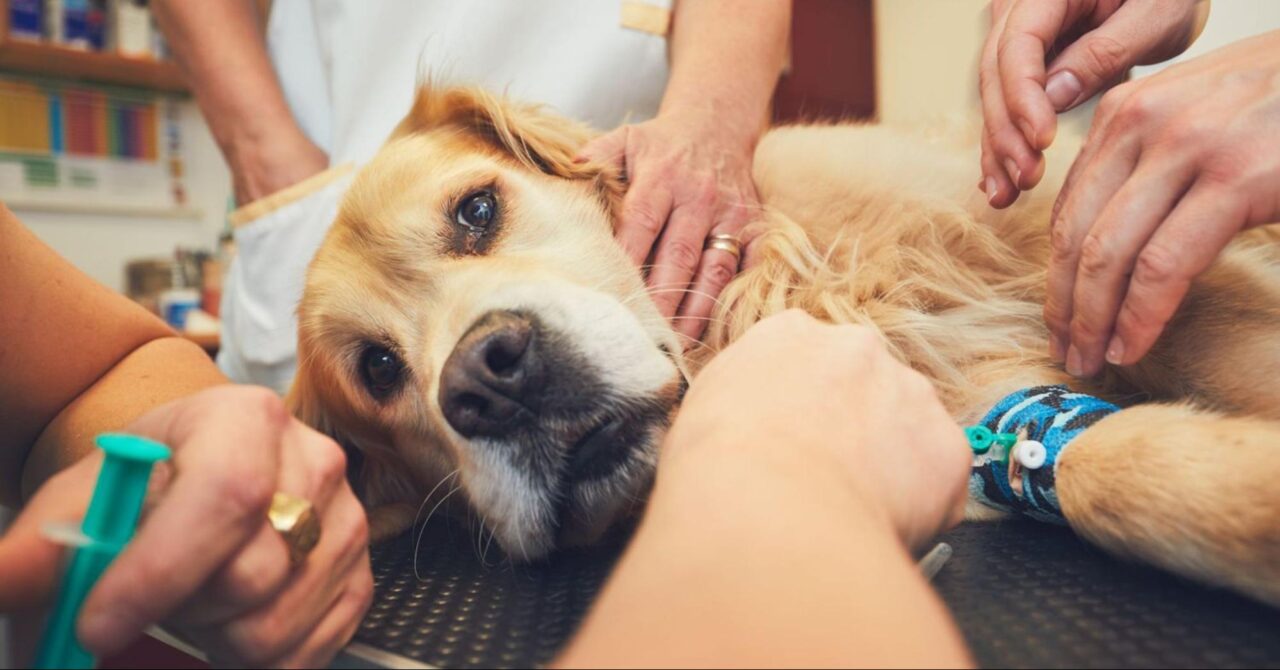
Your Dog’s Quality of Life Deciding when to euthanize a dog with cancer is an incredibly difficult and emotional decision for any pet owner. It’s important to consider your dog’s quality of life and well-being during this challenging time. Understanding the signs and symptoms of pain and discomfort in dogs with cancer helps guide you in making the right decision.
Assessing Your Dog’s Quality of Life
Determining your dog’s quality of life is a crucial step in deciding when to euthanize a dog’s with cancer. Remember that every dog is unique, and what may be tolerable for one dog may not be for another. Here are some factors to consider when assessing your dog’s quality of life:
- Pain management: Cancer can often be painful for dogs. Monitor how well your dog’s pain is being managed with medication and other pain relief methods. If your dog is in constant pain that cannot be effectively managed, it may be an indicator that their quality of life is deteriorating.
- Daily activities: Observe how well your dog can engage in their normal daily activities. Are they still able to eat, drink, and move around comfortably? If your dog is no longer able to enjoy these basic activities, it may be a sign that their quality of life has significantly declined.
- Mental state: Pay attention to your dog’s mental state. Are they still responsive, alert, and interested in their surroundings? Do they still show signs of affection and enjoyment in spending time with you and other family members? If your dog appears to be withdrawn, disoriented, or uninterested in their usual activities, it may indicate a decline in their mental well-being.
- Appetite and weight loss: Cancer can often lead to loss of appetite and weight loss in dogs. If your dog’s appetite has significantly decreased and they are experiencing rapid weight loss, it may be an indication that their body is not properly functioning and their quality of life is declining.
What Does Euthanasia Look Like?
Euthanasia is a deeply personal decision and should always be discussed with a veterinarian who can guide you through the process. When it comes to euthanizing a dog with cancer, it is important to understand what the process entails.
- Action: Before making the final decision, your veterinarian will have a consultation with you to discuss your dog’s condition, prognosis, and quality of life. They will help you understand the options available and whether euthanasia is the best course of action.
- Administration of sedatives: To ensure a peaceful and pain-free experience, your veterinarian will administer sedatives to relax your dog. These sedatives help your dog feel calm and comfortable during the procedure.
- Euthanasia solution: Once your dog is sedated, the euthanasia solution, usually a combination of medications, is administered. This solution is typically injected into a vein, causing your dog’s heart to stop beating and leading to a quick and painless passing.
- Saying goodbye: After the euthanasia is performed, you will have the opportunity to spend some time with your dog, saying goodbye and grieving. This time allows you to cherish the memories and provide closure for yourself.
When Your Dog’s Quality of Life Declines
When your dog’s quality of life declines due to cancer, When To Euthanize A dog’s With Cancer becomes a difficult and emotional journey for both you and your furry companion. It is important to closely monitor your dog’s overall well-being and consider their physical and mental state. Here are some factors to consider when determining if it is time to euthanize a dog with cancer:
- Pain management: Dogs with cancer may experience varying degrees of pain. If your dog’s pain is not well managed despite medical interventions, it can significantly impact their quality of life. Signs of pain can include changes in behavior, difficulty getting up or moving around, restlessness, and increasedization. Consult with your veterinarian to assess if your dog’s pain can be effectively relieved or if it is a sign that euthanasia may be the humane option.
- Physical symptoms: Cancer can manifest itself in various physical symptoms such as weight loss, loss of appetite, difficulty breathing, lethargy, and persistent vomiting or diarrhea. These symptoms can significantly impact your dog’s comfort and ability to enjoy daily activities. If your dog is experiencing severe physical distress that cannot be relieved or managed effectively, it may be an indication that euthanasia is the kindest choice.
- Mobility and independence: Cancer can often affect a dog’s mobility, making it difficult for them to walk, run, or perform simple tasks. As their condition progresses, your dog may become increasingly dependent on you for basic activities like going outside to relieve themselves or even getting up from a lying position. If their loss of mobility is causing them frustration or their independence is compromised, it may be time to consider euthanasia.
Emotional Well-Being
Dogs are highly sensitive creatures and can experience emotional distress just like humans. Cancer and its treatment can lead to behavioral changes such as aggression, withdrawal, anxiety, or depression. If your dog is no longer able to find joy in activities they once loved, or if they are exhibiting signs of distress that cannot be alleviated, it may be a quality-of-life indicator that euthanasia can provide them with peace and relief from their suffering.
- Daily activities and enjoyment: Pay attention to your dog’s ability to participate in their favorite activities. If they are no longer able to engage in activities they once enjoyed, such as playing fetch or going for walks, it may be a sign that their quality of life has significantly declined. Dogs thrive on mental and physical stimulation, when they can no longer engage in these activities, it can greatly impact their happiness.
When to Humanely Euthanize a Dog With Cancer?
How to Determine When to Euthanize a Dog with Cancer Determining when to euthanize a dog with cancer is a difficult decision that many dog owners have to face. It is important to consider the overall quality of life of your furry friend and consult with your veterinarian for guidance. Here are some additional factors to take into account:
- Pain management: The presence of cancer can often lead to severe and chronic pain in dogs. While medications and other treatment options can help manage pain to some extent, if your dog’s pain becomes unmanageable and affects daily life despite efforts to alleviate it, euthanasia may be a compassionate choice to prevent any further suffering.
- Appetite and weight loss: Cancer can often cause a loss of appetite in dogs. If your dog is consistently refusing to eat and is experiencing significant weight loss, it may be an indication that their body is no longer able to tolerate the effects of the disease. Weight loss can lead to weakness and a decline in overall health. If your dog’s appetite does not improve with medication or dietary changes, euthanasia may be a consideration to prevent further deterioration.
- Breathing difficulties: Depending on the type and location of cancer, it can sometimes affect the respiratory system, making breathing difficult for your dog. Signs of respiratory distress include coughing, wheezing, rapid breathing, and labored breathing. If your dog is struggling to breathe even at rest and medications or treatments are not providing relief, euthanasia might be the most compassionate choice to prevent your dog from suffering further.
- Mobility issues: As cancer progresses, it can affect a dog’s mobility and ability to move comfortably. If your dog is experiencing difficulty in standing, walking, or climbing stairs, it could be a sign that their condition is worsening. Mobility issues can significantly impact the quality of life and maybe a factor to consider when determining whether euthanasia is appropriate.
Decreased Interaction and Socialization
Dogs are social creatures and thrive on interaction with their human family members and other pets. If your dog with cancer is becoming increasingly withdrawn, avoiding social interactions, or no longer showing interest in spending time with loved ones, it could indicate that they are experiencing a decline in their overall well-being. Lack of socialization and decreased interaction can greatly affect their emotional and mental state, which should be evaluated when deciding on euthanasia.
- Worsening symptoms despite treatment: Although some dogs with cancer respond well to treatment, there may come a point where the disease progresses despite medical intervention. If your dog’s symptoms are worsening, they are experiencing frequent pain or discomfort, or the cancer is spreading to other parts of their body, it may be an indication that their condition is no longer manageable. In such cases, euthanasia may be a
- Mobility and comfort: Cancer can often cause pain and discomfort that may affect your dog’s mobility. If your dog is struggling to walk or move around, experiencing difficulty getting up or lying, or showing signs of constant discomfort despite pain management efforts, it may be an indication that their quality of life is greatly compromised. Euthanasia can relieve them from their suffering and ensure they are not enduring unnecessary pain.
What Is the Quality-of-Life Scale for Dogs?
The quality-of-life scale for dogs is a tool that can help owners assess their dog’s well-being and determine if euthanasia may be the most humane option. This scale is a way to objectively evaluate various aspects of a dog’s life and assign a score to each category. These categories often include mobility, appetite, hydration, pain, behavior, and enjoyment of life.

By using the quality-of-life scale, pet owners can track the progression of their dog’s condition and make informed decisions about their care. Each category on the scale is assessed on a numerical scale, with higher scores indicating a better quality of life. Along with working with a veterinarian, using the quality-of-life scale can provide an objective perspective on the dog’s overall well-being, helping to guide decisions regarding euthanasia.
Typically, the quality-of-life scale involves evaluating factors such as pain management, physical comfort, ability to perform daily activities, response to treatment, overall happiness, and the presence of any distressing symptoms. Each category is given a score, and these scores are then aggregated to provide an overall assessment of the dog’s quality of life.
It’s important to note that the quality-of-life scale is not a definitive tool, but rather a guide to help pet owners make a more informed decision about when to euthanize a dog with cancer. It serves as a starting point for discussions with veterinarians and can provide valuable insight into the dog’s well-being.
When Their Pain in Life Exceeds the Pleasure?
When a dog’s pain in life exceeds their pleasure, it may be time to consider euthanasia. As much as we want our furry friends to experience joy and happiness, it is essential to prioritize their well-being and prevent them from suffering unnecessarily.
Recognizing when a dog’s pain outweighs their pleasure can be challenging, as dogs often hide their discomfort. However, several signs can indicate when a dog’s quality of life has significantly declined. These signs may include:
- of appetite: If your dog has no interest in eating or has a decreased appetite, it could be a sign that they are experiencing pain or discomfort.
- Difficulty in mobility: If your dog is having trouble walking, climbing stairs, or getting up from a lying position, it may indicate that their pain is impairing their physical abilities.
- Reduced interaction and enjoyment: Dogs that were once social and active may become withdrawn, disinterested in their favorite activities, or isolated from their family members. This behavior change can be a sign that they are experiencing pain or have a decreased quality of life.
- Frequent and severe pain: If your dog is experiencing chronic pain that is not adequately managed with medication or other treatments, it may be an indication that their pain outweighs their pleasure.
- Decline in overall health: Cancer can weaken a dog’s immune system, making them more vulnerable to infections and other health issues. If your dog’s overall health is declining, it may be a strong indicator that their pain is outweighing their pleasure. It’s important to monitor your dog’s overall well-being and consult with your veterinarian to assess their quality of life.
What are the Signs of Suffering in Dogs?
Recognizing signs of suffering in dogs is crucial when considering euthanasia for a dog with cancer. While dogs may not be able to their pain directly, they often exhibit various physical and behavioral indications of distress. Here are some common signs of suffering in dogs:
- Excessive panting or difficulty breathing: If your dog is panting excessively or having trouble breathing, it could indicate pain or discomfort. This may be especially noticeable if their cancer has metastasized to the lungs.
- Lethargy and weakness: Dogs that are suffering from cancer may show signs of lethargy, appearing tired and lacking energy. They may have difficulty getting up, walking, or performing basic functions they once did with ease.
- Changes in behavior: Dogs experiencing pain may exhibit changes in their behavior. They may become more irritable, aggressive, or even fearful. Conversely, they may withdraw and become less social or interactive.
- Loss of interest in activities: A dog’s loss of interest in activities they once enjoyed, such as playing, going for walks, or engaging with their favorite toys or treats, can be a sign of suffering. They may also exhibit a general disinterest in their surroundings.
- Changes in appetite: Dogs with cancer may experience a loss of appetite or have difficulty eating and drinking. This can result in weight loss and malnutrition, further impacting their overall health and well-being.
How Do you Know When to Euthanize a Dog with Cancer?
Deciding to euthanize a dog with cancer is never, but it is a compassionate choice to alleviate their suffering when their quality of life is significantly compromised. Here are some factors to consider when determining if it is time to euthanize a dog with cancer:
- Pain management: Despite efforts to manage pain with medications and other treatments, if your dog’s pain becomes unmanageable and significantly affects their daily life, it may be an indication that euthanasia is necessary. Chronic pain can be detrimental to a dog’s well-being and overall happiness.
- Loss of mobility: Cancer can affect a dog’s ability to move comfortably. If your dog has difficulty walking, climbing stairs, or getting up and down, it may be a sign that their cancer has progressed to a point where their quality of life is severely compromised.
- Loss of bodily functions: When a dog’s cancer reaches an advanced stage, it can impair their ability to control their bodily functions. If your dog is experiencing frequent accidents or has difficulty urinating or defecating, it can significantly impact their comfort and quality of life.
- Failure to respond to treatment: If your dog’s cancer is not responding to treatment or if the treatment options have been exhausted and there are no other viable options, it may be time to consider euthanasia. It’s essential to consult with your veterinarian to understand the effectiveness of the treatments being administered and to explore any alternative options that may be available.
What is Hemangiosarcoma in Dogs?
Hemangiosarcoma is a type of cancer that commonly affects dogs. It originates in the blood vessels and can occur in different organs, most commonly the spleen, liver, and heart. This type of is aggressive and can spread quickly, making it a particularly challenging diagnosis.

When considering euthanasia for a dog with hemangiosarcoma, it’s crucial to consult with your veterinarian to gain a better understanding of the dog’s prognosis and overall quality of life. They will be able to provide you with specific information about your dog’s condition and help guide you through the decision-making process.
Making the Decision: Euthanasia is a deeply personal decision that should be based on the best interests of your dog. When it comes to a dog with cancer, including hemangiosarcoma, some key considerations may include:
Pain control: Dogs with hemangiosarcoma may experience Signs of hemangiosarcoma vary depending on the location of the tumor but may include lethargy, weakness, decreased appetite, and weight loss. Dogs with hemangiosarcoma may also exhibit symptoms such as difficulty breathing, pale gums, and abdominal distension if the tumor is in the spleen or liver.
1. Limited Mobility
As the tumor grows and spreads, it can put pressure on surrounding organs and tissues, causing pain and discomfort for your dog. This may result in limited mobility, making it difficult for them to, run, or even get up and down the stairs. If your dog is struggling with mobility issues, it can greatly affect their overall quality of life.
2. Changes in Behavior
Dogs with cancer, including hemangiosarcoma, may exhibit changes in behavior. They may become withdrawn, lose interest in activities they once enjoyed, or show signs of aggression or irritability. These behavioral changes can indicate that your dog is experiencing pain or discomfort, which can be a significant factor to consider when deciding on euthanasia.
3. Decreased Appetite and Weight Loss
Hemangiosarcoma can affect a dog’s appetite, leading to a decrease in food intake and subsequent weight loss. A significant loss of weight can be a sign that the cancer is progressing and impacting your dog’s ability to maintain their body condition. If your dog’s appetite continues to decline despite attempts to entice them to eat, it may be an indication that their quality of life is declining.
4. Difficulty Breathing and Pale Gums
Hemangiosar sarcoma is a highly invasive cancer that often goes undetected until it has reached an advanced stage. Signs of hemangiosarcoma vary depending on the location of the tumor but may include lethargy, weakness, decreased appetite, and weight loss. Dogs with hemangiosarcoma may also exhibit symptoms such as difficulty breathing, pale gums, and abdominal distension if the tumor is in the spleen or liver.
What Can We Do to Make this Process Easier for Our Pets?
When facing the difficult decision of euthanizing a dog with cancer, there are a few steps you can take to make the process as easy and comfortable as possible for your beloved pet:
- Consult with your veterinarian: Your veterinarian an invaluable resource during this time. They can assess your dog’s condition, discuss treatment options, and provide guidance on when euthanasia may be the most humane choice. They can also help you understand the potential signs of pain or discomfort that your dog may be experiencing.
- Consider your dog’s quality of life: It is important to evaluate your dog’s overall quality of life. Look for signs of pain, distress, or lack of enjoyment in everyday activities. If your dog is consistently experiencing pain or has lost interest in things they once loved, it may be an indication that their quality of life is diminishing.
- Discuss palliative care options: If euthanasia is not an immediate consideration, your veterinarian may be able to provide palliative care options to help manage your dog’s symptoms and keep them comfortable. This may include pain medications, dietary changes, or other supportive therapies. Palliative care can help improve your dog’s quality of life during their remaining time.
- Plan for a peaceful goodbye: It is essential to create a calm and comfortable environment for your dog’s final moments. Choose a quiet and familiar space where your pet feels safe and secure. You may want to lay down soft bedding or blankets to provide extra comfort. Consider playing soothing music or using aromatherapy to create a peaceful atmosphere.
When to Euthanize a Dog with Cancer?
It can be an incredibly difficult decision to make when it comes to deciding when to euthanize a dog with cancer. Each dog and situation is unique, but there are certain factors to consider when assessing their quality of life. This section will provide you with more guidance on determining when it may be time to consider euthanasia for your beloved pet.
- Pain management: One crucial aspect to consider is your dog’s ability to manage pain. Cancer can cause severe pain and discomfort as it progresses. Despite medical interventions and pain management treatments, there may come a point where your dog’s pain becomes unmanageable. If your dog is consistently in pain despite efforts to alleviate it, euthanasia may be the most compassionate option to prevent further suffering.
- Decline in overall health: As cancer progresses it can take a toll on your dog’s overall health. You may notice weight loss, weakness, and a decline in organ function. If your dog’s body is no longer able to fight off the disease or manage its symptoms, it may be an indication that euthanasia is the most humane decision. It is important to consider the impact on your dog’s quality of life and prevent any unnecessary suffering.
- Difficulty in performing everyday activities: Dogs with cancer may struggle to perform basic everyday activities such as eating, drinking, walking, or using the bathroom. If your dog is no longer able to do these activities independently or without significant pain and discomfort, it may be a sign that their condition has significantly worsened. It is crucial to assess their ability to carry out these activities and determine if euthanasia is the best course of action to relieve their suffering.
- Response to treatment: If your dog has been undergoing cancer treatment and there is little to no improvement or even a worsening of their condition, it may be an indication that the treatment is no longer effective. In some cases, the side effects of treatment can also negatively impact your dog’s quality of life. It is important to evaluate the response to treatment and consider if it is worth continuing if it is not providing any significant benefits for your dog.
Conclusion
The decision to euthanize a dog with cancer is a difficult and deeply personal one. It is important to consult with your veterinarian to assess your dog’s overall health, pain management, decline in activities, and response to treatment. These factors can help you determine when it may be the most compassionate choice to let your beloved pet go.
The emotional aspect of euthanizing a dog with cancer cannot be overlooked. It is natural to feel a range of emotions, including grief, guilt, and. However, by prioritizing your dog’s well-being and quality of life, you are making a compassionate decision. Remember that your veterinarian is your best source of guidance and support during this difficult time.
It is important to have an open and honest discussion with your veterinarian about your dog’s prognosis and treatment options. They can provide valuable insight into the progression of the disease and its impact on your dog’s quality of life. Ultimately, the decision to euthanize should be based on what is best for your dog.
While it is heartbreaking to think about letting go of your beloved pet, it is essential to consider their suffering. Euthanasia can offer a peaceful and painless end to their suffering, ensuring they are spared from further distress. Remember that euthanasia is a loving and selfless decision that is often made to prevent unnecessary pain and ensure your dog’s dignity in their final moments.
FAQ
How long should I let my dog live with cancer?
Determining how long to let your dog live with cancer depends on multiple factors including:
-
- Quality of Life: Assess their overall happiness, appetite, mobility, and comfort.
- Type and Stage of Cancer: Some cancers are more aggressive and painful, while others may be manageable for longer periods.
- Treatment Options and Side Effects: Consider the impact of treatments on their quality of life.
- Veterinarian Guidance: Regular consultations with your vet to monitor your dog’s condition are essential. Ultimately, prioritize your dog’s comfort and well-being, making decisions guided by your veterinarian’s advice and the observable quality of life.
How do I know if my dog with cancer is suffering?
Indicators that your dog may be suffering from cancer include:
-
- Behavioral Changes: Unusual aggression, hiding, or withdrawal.
- Appetite Loss: Refusing to eat or drink, leading to weight loss.
- Mobility Issues: Difficulty moving, limping, or reluctance to engage in normal activities.
- Pain Manifestations: Whining, crying, or changes in posture indicating discomfort.
- Pale Gums or Labored Breathing: Signs of systemic issues like anemia or respiratory distress.
- Vomiting or Diarrhea: Persistent gastrointestinal symptoms. Consult your veterinarian if you notice these symptoms to evaluate pain management and potential end-of-life care.
How do I make my dog comfortable when dying of cancer?
To comfort your dog as they nears the end of life:
-
- Pain Management: Administer prescribed medications to control pain.
- Comfortable Environment: Provide a soft bed in a quiet, familiar space.
- Hydration and Nutrition: Offer easy-to-eat foods and ensure they stay hydrated.
- Gentle Care: Support their movements and keep them clean.
- Emotional Support: Spend quality time with them, providing affection and reassurance.
- Veterinary Support: Regularly consult your vet to adjust care plans and manage symptoms effectively. Consider discussing end-of-life options like euthanasia with your vet if your dog’s quality of life significantly declines.
Can dogs with cancer have good days and bad days?
Yes, dogs with cancer often experience fluctuations in their condition:
-
- Variation in Energy Levels: They may have days when they seem more like their usual selves and other days when they are more lethargic.
- Appetite Changes: They might eat voraciously some days and barely touch food on others.
- Behavioral Swings: Mood swings are common, indicating pain or discomfort variability. Document these patterns and share them with your veterinarian, as they can provide valuable insights into your dog’s condition and the effectiveness of their treatment plan.













